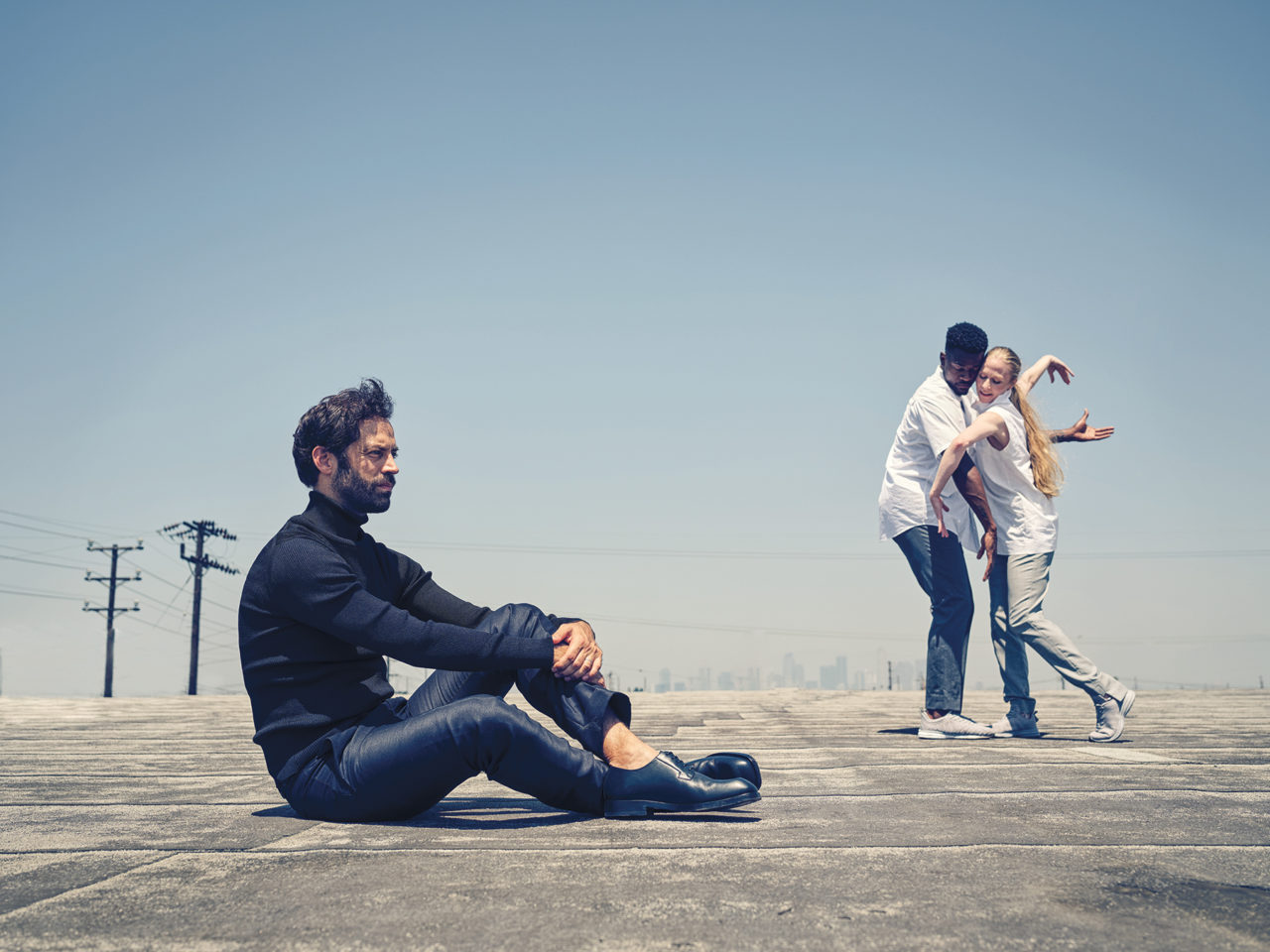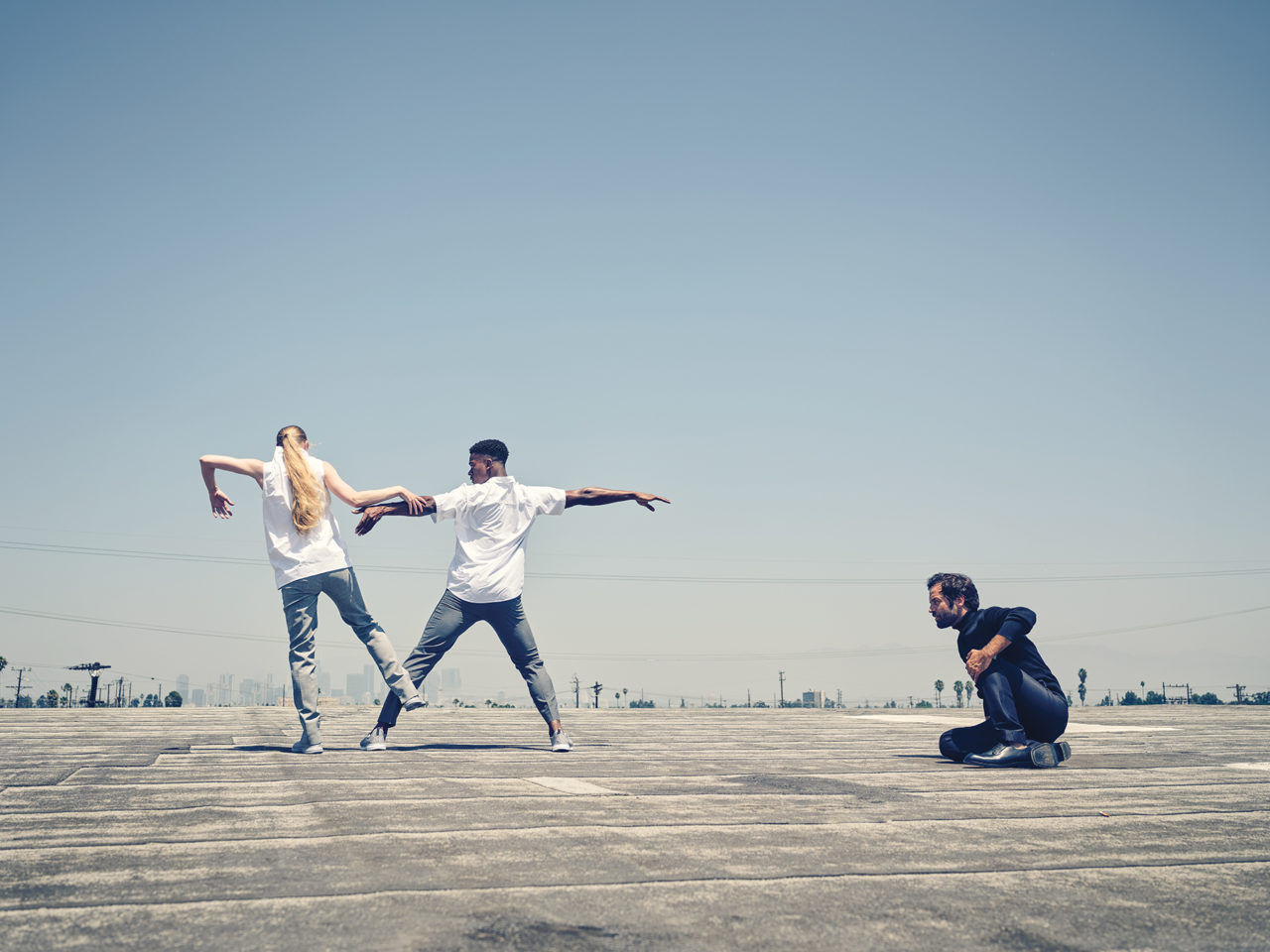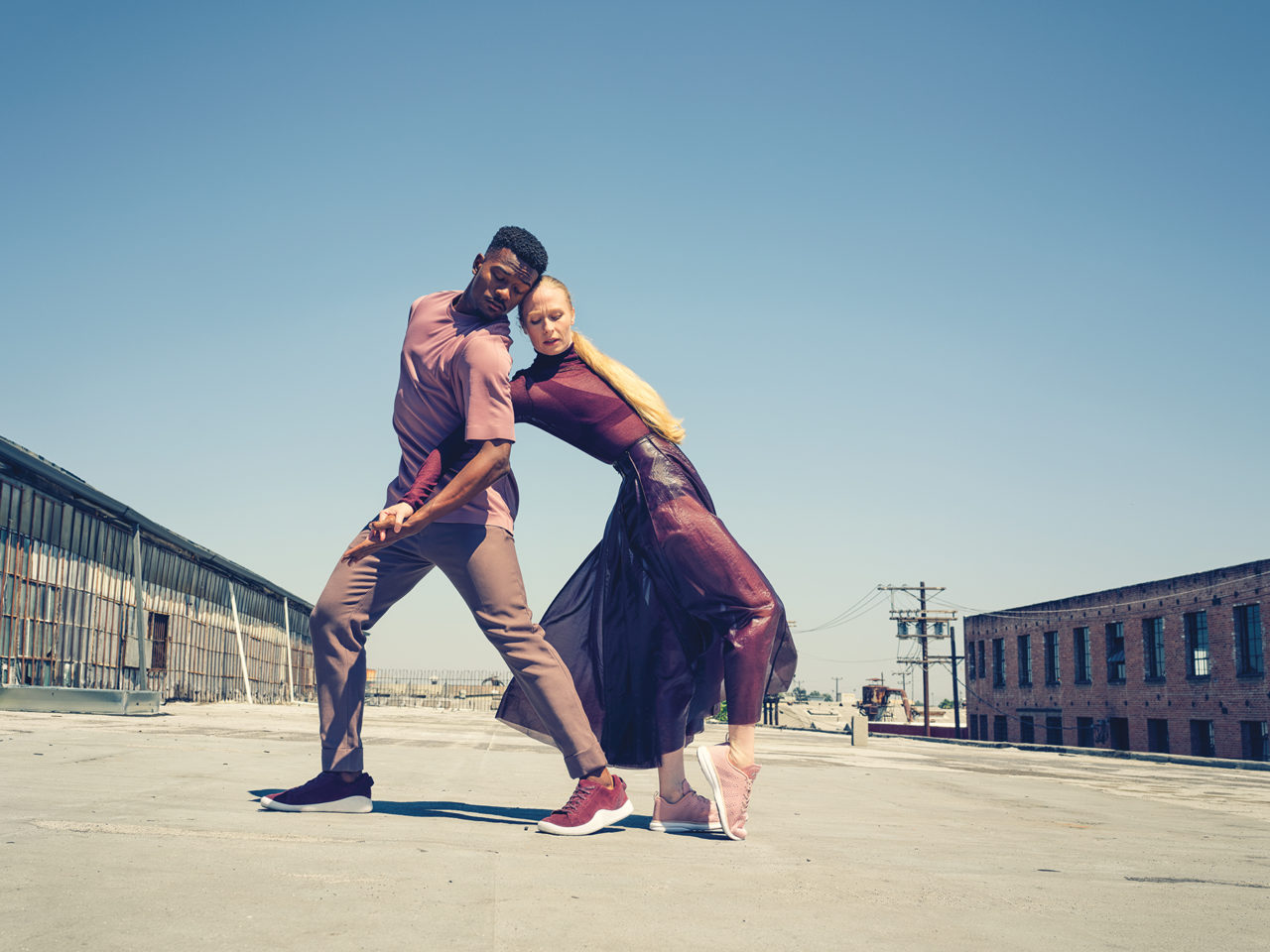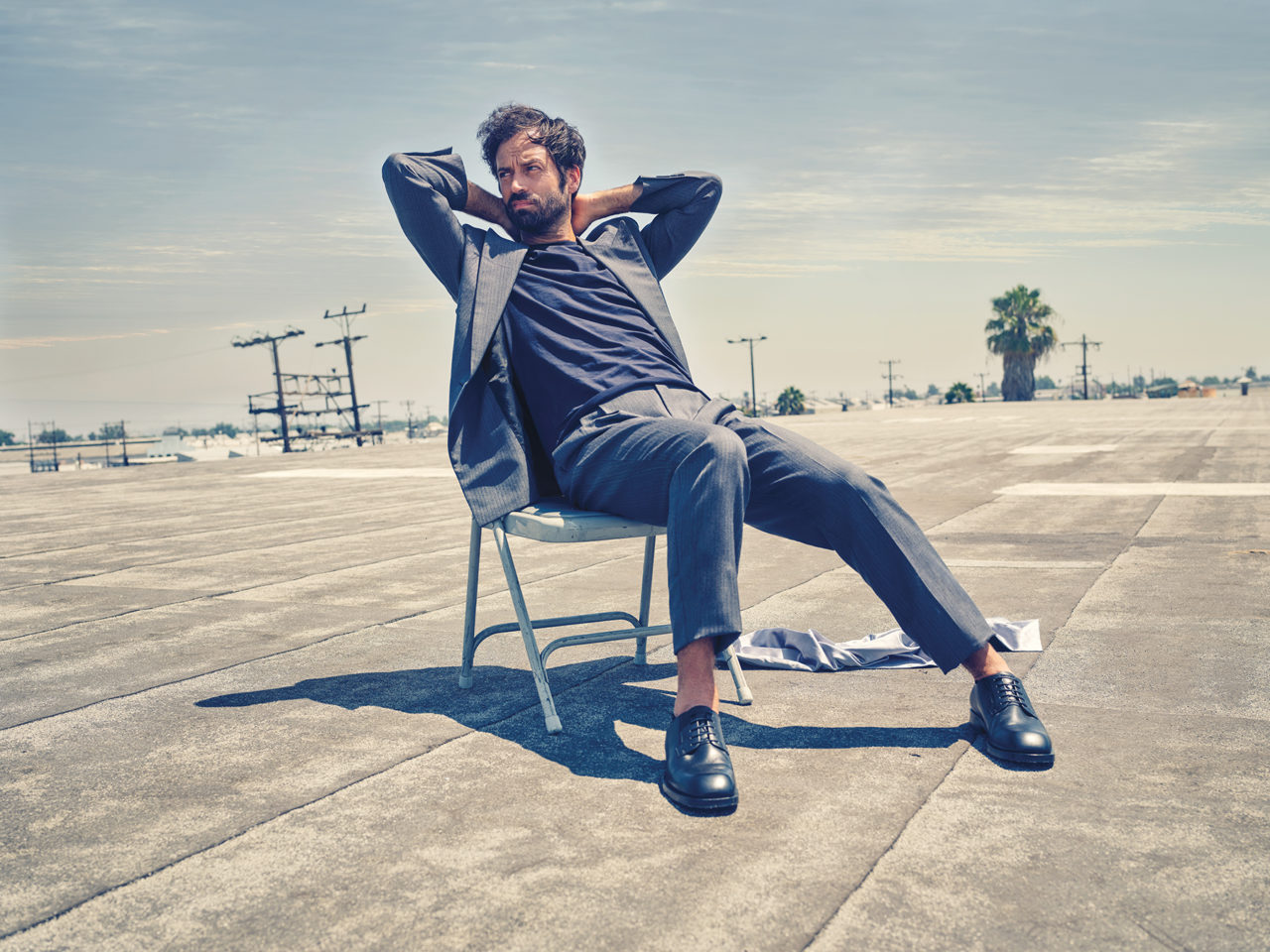Formerly based in Paris and New York, he was one of ballet’s biggest names. So why make the leap to the West Coast?
Words by DAVID HOCHMAN
Photography by KURT ISWARIENKO
Creative and Fashion Direction by ALISON EDMOND
Having retired from the New York City Ballet nearly a decade ago, Benjamin Millepied no longer dances. “Moving around in the kitchen to Stevie Wonder is about as far as it gets,” he says, adding you’re far more likely these days to catch him at a women’s soccer match than practicing his pirouettes. “Megan Rapinoe reminds me of the skills of ballet,” he says of the U.S. soccer team captain. “She can basically move with anything that comes at her.”
You can say the same about Millepied. Up on a rooftop in South Los Angeles, he’s watching a pair of lithe performers who represent the future of dance in L.A., a city where, as Millepied puts it, “the history of dance is mostly about failures.” Los Angeles never really supported a major ballet company until Millepied co-founded L.A. Dance Project in 2012. Today, as two of his troupe’s lead dancers trade sweaty glissades and double turns behind him, the company’s artistic director can pride himself on having built an arts organization even Paris or New York can’t quite match.
“Where do I begin, really?” Millepied says about the city’s appeal as a culture capital. At 42, he is delicately built, 5-foot-10 and 160 pounds, but there’s something ruggedly masculine about him. In a taut black turtleneck and black knit pants, Millepied could easily pass for a Tom Ford model. “Everything is possible in Los Angeles,” he says. “On one hand, L.A. is a complete mess — totally chaotic, sprawling, a tangle of contradictions as far as architecture and the distribution of wealth. But there’s humanity and expression and fascination in that. It makes this city endlessly interesting and stimulating to me.”
It was Hollywood that first brought Millepied to the general public’s attention, though he was already huge in the dance world. Before he choreographed and performed in Darren Aronofsky’s award-winning 2010 film Black Swan — and famously walked away with its star, Natalie Portman, his wife since 2012 and the mother of their two children — Millepied was among the world’s most acclaimed men in tights.
Born in Bordeaux, France, in 1977 to a decathlete and a ballet dancer, Millepied started dancing at 5 and by 13 was a standout at the Conservatoire National Supérieur Musique et Danse de Lyon. Later, even before completing his training at the School of American Ballet in New York, where he studied on a scholarship full time, Millepied originated a lead role in West Side Story choreographer Jerome Robbins’ 2 & 3 Part Inventions. By 1995 he was dancing with the New York City Ballet, where he rose to soloist within three years, and principal dancer by 2001. Meanwhile, his choreography landed on stages at the Paris Opera (Millepied served as director of dance at the Paris Opera Ballet from January 2013 until he resigned in 2016), and the Baryshnikov Arts Center in New York, where he created a solo piece, Years Later, for Mikhail Baryshnikov himself. “I danced for 20 years very intensely and while it was not easy on the body, it opened my life to many, many wonders,” Millepied says.
“L.A. is a tangle of contradictions. But there’s humanity and expression and fascination in that”
Benjamin Millepied
Now his focus is almost exclusively behind the scenes. Millepied, among much else, is adapting and directing the opera Carmen into a feature-length film (due out next year) with a score by Academy Award–nominated Moonlight composer Nicholas Britell. Currently on his mind: A six-week, 13-piece series of L.A. Dance Project performances at the company’s 2245 studio space downtown this fall, featuring a piece created in collaboration with London-based, Swedish-owned fashion brand COS. (The series runs through November.) “What I appreciate most about L.A. is how open it is to unusual ideas, partly because it’s not overly formal or conservative. You’re not tied to convention here or to ‘we do it this way, and that’s that,’ and that gives you enormous freedom as an artist,” he explains.
But there is one area where he’s not so open to expression. Ask Millepied about his private life — what it’s like being married to one of the most famous actors on the planet; what his experience is like, say, walking down the street alone versus with Portman — and the proverbial needle skids across the vinyl. “It’s not something I pay attention to, and it’s really all OK,” Millepied says in response, pulling his turtleneck up around his chin.
Millepied and Portman started dating during the filming of Black Swan, and the actor was pregnant when she won the Oscar, sweetly namechecking Millepied during her acceptance speech for giving her “my most important role of my life.” Their son, Aleph, was born in June 2011, and daughter, Amalia, arrived in February 2017. I ask how his children’s lives are different from his own childhood. “Oh, you know, not so different in some ways; very, very different in others,” he says. “They’re children and they’re wonderful.”
In fact, the quick snapshot he gives me of his early life sounds like the opening scene of a Tintin adventure. “We were bohemians. We crossed the Mediterranean on a tiny sailboat when I was 4 months old and traveled up the Gambia River to Senegal, where I lived until I was 5. That’s when I started to dance.” His mother was his first teacher and taught him that “dance wasn’t about the audience, and certainly not about money, but more about a wildness of passion and a response to music felt deeply within.”
Budgets and boards now require Millepied to stress a bit more over profits, which may explain why he lies low when he’s not working. He says he has no real hobbies other than a little biking and photography, though he acknowledges a weakness for collecting furniture from the Bauhaus period and the arts and crafts movement. Fashion is not especially important to him (“I would describe my style as comfortable, which doesn’t always mean stylish”) and he finds creative inspiration from a broad range of sources: the classical compositions of Nico Muhly, the feminist essays of Rebecca Solnit, vintage tango videos on YouTube.
A little later in a downstairs photo studio, Millepied is blunt about how tough it is running an arts organization in Donald Trump’s America. Three years in a row, the president’s proposed budget plan called for shuttering the National Endowment for the Arts, the National Endowment for the Humanities, and the Corporation for Public Broadcasting. Getting government backing for a group like his is “mission impossible,” Millepied says, which is why he’s grateful for brands that step in with hefty support where D.C. foundations once might have provided the ducats. “With so much going on around immigration, poverty and the environment, people aren’t as likely to donate [to the arts], even though the need for artistic expression has never been greater.”
Millepied makes it work. L.A. Dance Project now has 12 full-time dancers and the company performs at venues around the world. This fall’s multipiece series — featuring sets designed by local visual artists such as Njideka Akunyili Crosby and Charles Gaines — includes six world premieres. Among the new works is a piece from choreographer and principal dancer Janie Taylor created in collaboration with COS, which also supplied the costumes.
“Benjamin’s desire to take the art form to an audience that might not otherwise see it felt very connected to our values,” says Atul Pathak, a spokesman for COS, whose parent company is H&M. “LADP’s spirit and creativity is exciting, and we were particularly attracted to partnering with them because they are aiming toward younger patrons, and the tickets are incredibly affordable” — as low as $10 for some performances — “making it more open and democratic.” On the ritzier end, a Paris dance production of Romeo & Juliet that Millepied is readying for next May at La Seine Musicale features massive Renaissance-style sets bejeweled with Van Cleef & Arpels gemstones, and the dancers projected in black and white on a giant screen.
With so much on the horizon, it makes one wonder how Millepied finds his center of gravity. I want to inquire about his conversion to Judaism, which he completed a few years after his wedding (he admits that he reads a ton of Abraham Heschel), and about the everyday home life he and Portman enjoy in a leafy little mountain town north of Los Angeles. But by now, Millepied’s turtleneck — I kid you not — is pulled up over his mouth and one eye as he talks. “I really like my privacy,” he says gently, lowering his collar as a smile takes over his face.
Hair and Makeup by MIRA CHAI HYDE at The Wall Group using Skuff Potion and Caudalie
This story originally appeared in the October 2019 issue of C Magazine.
Discover more CULTURE news.








